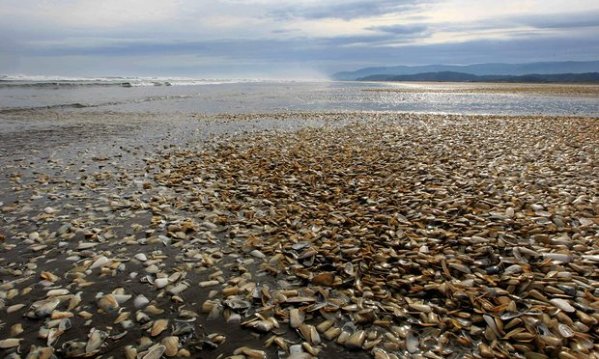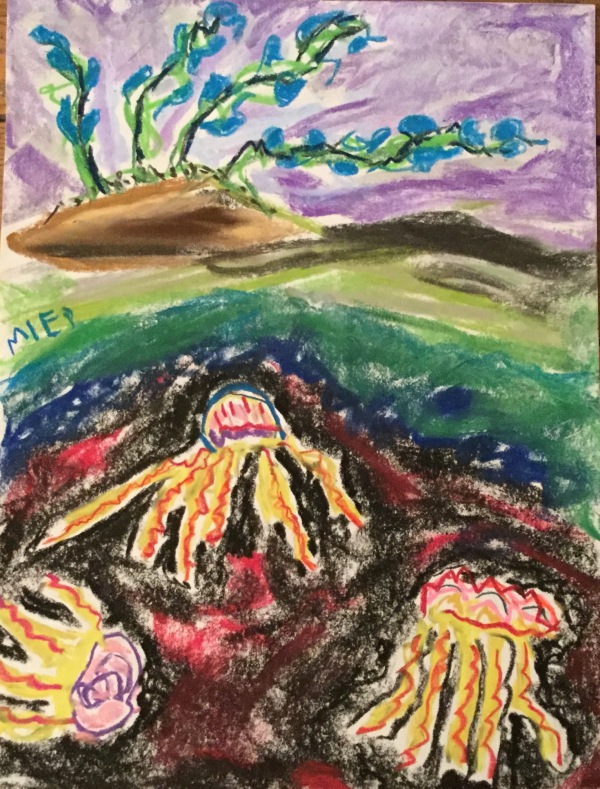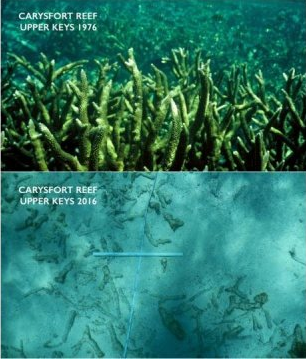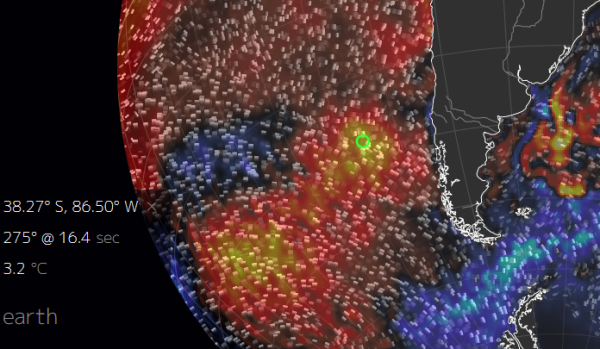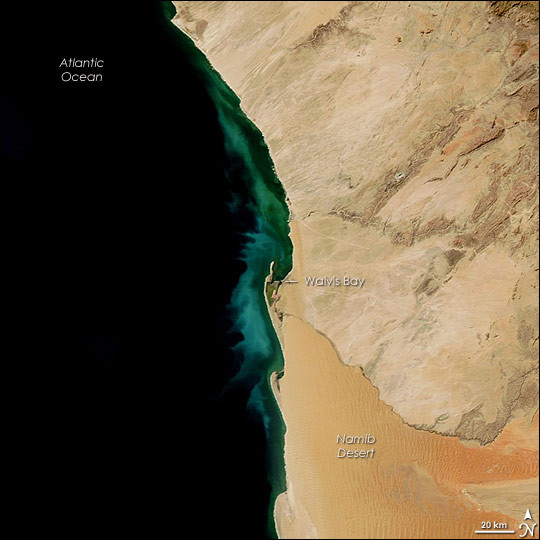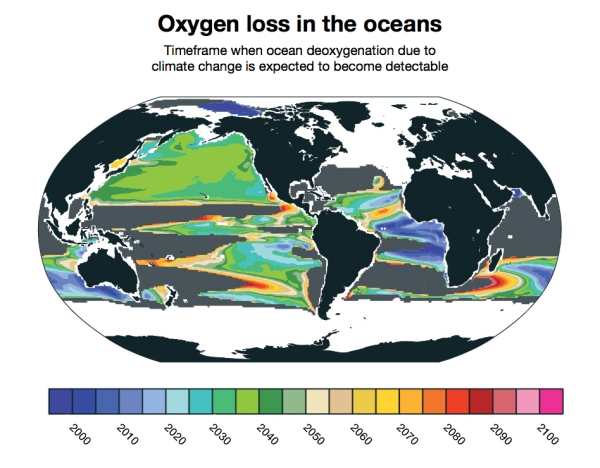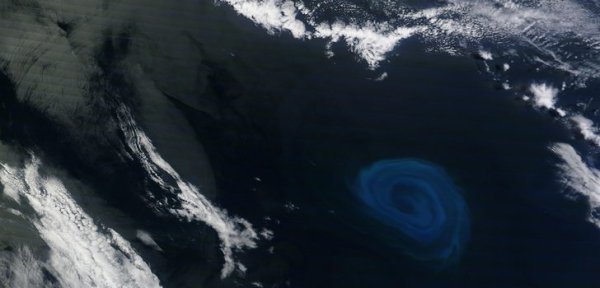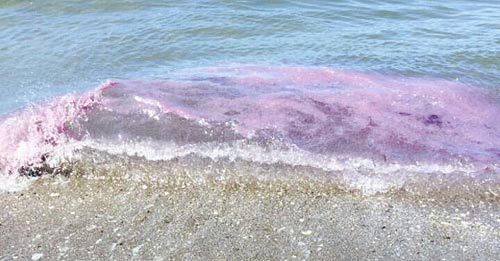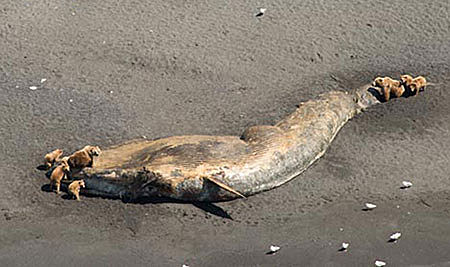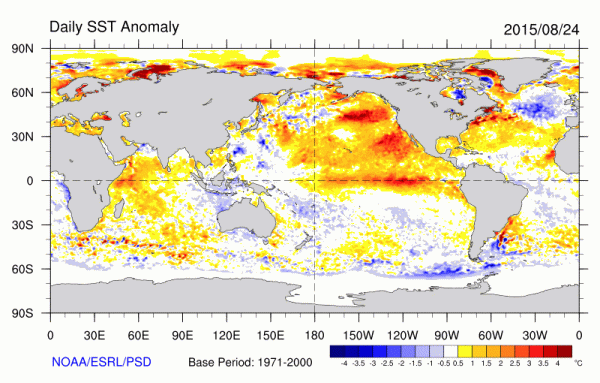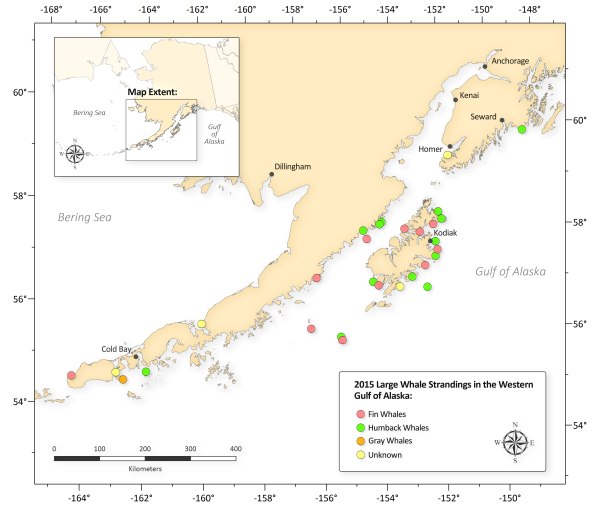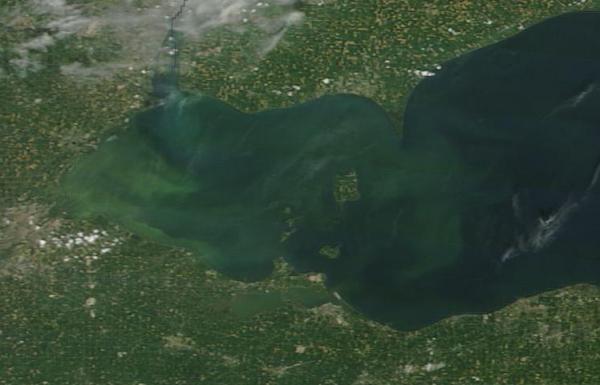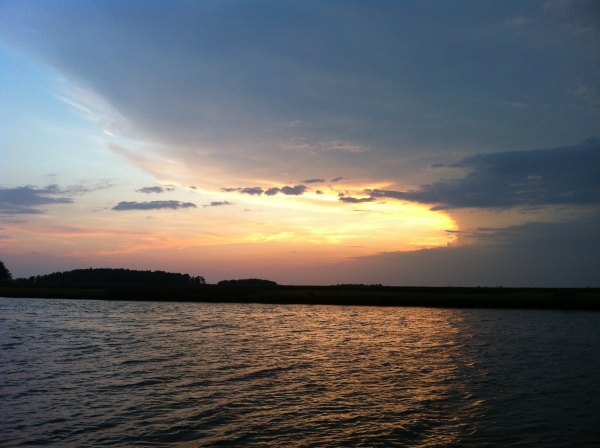We should be very clear. There is no way to save the beautiful and majestic coral reefs of our world without a rapid cessation of fossil fuel burning. And, if we continue burning fossil fuels, we will not only lose the reefs and corals — we will also turn the world’s oceans into a mass extinction engine.
(Masses of dead sea life wash up onto Chile’s shores after the worst red tide in history for that nation. As we witness the tragic carnage in Chile, we should remember that the red tide there, the mass coral bleaching in the Great Barrier Reef of Australia, and the onset of ocean acidification damage to the Florida Reef are all linked by the same thread — fossil fuel burning and a related heating up of the global climate. Image source: Largest Red Tide in Chilean History.)
Mass Extinction Driven by the Awful Engine of Greed
Killer Seas. That’s what we’re turning the world’s oceans into in our allowing the fossil fuel industry to retain dominance over the world’s energy sources. In allowing them to continue to keep us captive to the burning of high carbon fuels through their corrupting and pervasive political and economic power. We certainly bear some of the blame for apathetically allowing ourselves to be hood-winked and lead about by the noses. But we shouldn’t fault ourselves too much. For the blame mostly rests within the policy-making apparatuses of dominance-based economic systems and in the very few individuals around the world who now hold the keys to that power.
An enforced global injustice set in place by wealthy individuals like the Koch Brothers, Rupert Murdoch and Warren Buffet — who through a corrupt monetary influence regularly hijack the political process to protect legacy fossil fuel assets and to assault renewable energy industries. Those like the members of the governing board of Exxon Mobile — who have waged a decades-long campaign to misinform the public on the dangers of human-caused climate change. These so-called global elites are the authors of the climate change denial that has now crippled and deeply divided most legislative bodies around the world. The same fossil fuel drug pushers who’ve worked so hard to keep the global economic system addicted to the most damaging and corrupting of energy sources — oil, gas and coal.
These people are the real monsters of the climate crisis. The ones who, often without any kind of visibility or accountability, have done everything they can to ensure that we, the people of an ailing Earth, have less and less power to make the right decisions and to form the kind of political consensus that would actually provide a pathway to leading us out of this worsening global nightmare. And so, whether we individually realize it now or not, we are in the fight of our lives — what is likely to be the most important struggle for justice that the human race has ever undertaken. For as difficult as such a fight will ultimately be — we must fight the fossil fuel interests and win if human civilization and much of life on Earth is to survive.
The Advent of Killer Seas
I don’t usually talk about religion here in this blog. And I’m not what many people would consider to be a religious person. I do not, for example, attend church very often. Nor do I tend to agree with many so-called religious authorities — whom I often see as short-sighted and relying too much on mythical and dogmatic beliefs that are at best failures in logic and at worst the outgrowths of institutional corruption or general backwards-thinking and small-mindedness. But in this particular case — in the case of the killer seas that are starting to plague our world — I cannot help but to often be struck by how one of the deadly sins that the Bible warns of is resulting in so much terrible harm to the Earth, to its creatures, and to her people. And it is impossible to turn away from the clear-sighted and beautifully written moral imperative laid down by the Pope Francis in his Encyclical. A warning that we should all heed and not turn our eyes from.
(Nothing is Frozen — by Miep. This is what happens when the world loses its ice — Killer Seas. Image source: There are So Many Things Wrong With This.)
For in the book of Revelation, the Bible speaks of a terrible global disaster. One that begins when the seas turn blood-red and a third of all the fish are killed. Many have interpreted this book, this passage, as a kind of inevitable wrath of a literal God coming down from heaven to divide and punish the human race. But I think that this is a false interpretation. A loving, nurturing God is not a God of Wrath. No, that does not ring true to me at all. I think of this passage, this book, instead as a kind of stark warning against the direct and deadly consequences of bad actions. Of what happens to us if we succumb to what the Bible identifies as the sin of greed. For ‘the love of money is the root of all evil.’
The Bible is, after all, a sort of lore of the ancients passed down over hundreds of generations. A book of parables and lessons for how human beings should treat one another in ways that help not only individuals — but the entire race to survive. In this way, the Bible could be seen as an ancient guide for civilization survival. A book that includes numerous passages on how cities and nations can prosper by living in balance with one another and with nature. And one that issues this essential and stark warning to those who do not treat the Earth and her creatures with kindness. For ‘those who destroy the Earth shall be destroyed.’
Well, we’ve already destroyed 2/3 the globe’s predatory fish that humans eat through over-fishing alone. But the kind of ocean-wrecking destruction of callously-over-fishing pales in comparison to what happens when the short-sighted protection of money in the form of ‘legacy fossil fuel assets’ forces the dumping of billions of tons of toxic carbon into the world’s airs and waters. If you do that, then the ocean really does turn blood-red and purple-red. If you do that, you unleash the mass extinction machine that was the killing mechanism in four of the five great die offs in Earth’s deep history. You begin to temp the fates by invoking the names Permian, Triassic, Devonian, and Ordovician. And if you allow the fossil fuel powers to keep on doing it for the sake of their imagined wealth, then you make the oceans so acidic that the skeletons of the fragile and yet ever-so-beautiful and necessary creatures living within the world’s waters dissolve.
Florida’s Coral Reefs Start to Dissolve
Here, we’ve frequently warned of the two-pronged threat posed to global coral reefs as a result of human fossil fuel burning. In the south, as oceans heat up due to fossil fuel emissions, coral bleaching begins to take hold. Becoming more pervasive as temperatures rise into a range between 1 and 2 C above preindustrial averages, by the 2030s about 90 percent of the world’s reefs will fall under threat of ghosting away into whiteness.
This year, we saw some of these stark consequences begin to unfold as the Great Barrier Reef suffered a horrific bleaching event. This kind of event was predicted and expected by ocean researchers. Brave scientists who acted as modern-day prophets in their issuing of warnings to Australian and global governments. Governments which are now, in so many cases, stacked to the gills (due to the corrupting influence of fossil fuel money mentioned earlier) with the political extremists we today call climate change deniers.
The second prong of the threat to global reefs comes in the form of ocean acidification spreading down from the north. Because waters in northern regions of the world are colder, they are able to take in more of the excess greenhouse gasses produced. As more carbon is drawn into these colder waters, their acidity increases to the point that ocean organisms with calcium carbonate skeletons begin to see those skeletons dissolve. And corals are one of many key ocean organisms that possess calcium carbonate skeletal structures.
(A global ocean acidification front resulting from a rampant burning of fossil fuels is starting to dissolve higher latitude reef systems. The Carysfort Reef — above — has had numerous coral structures completely dismembered due to ocean acidification creeping into this section of the Florida Reef. Image source: Science Daily.)
Until recently, the threat of ocean acidification to reef systems was still thought to be at least a couple of decades off. And many mainstream scientists believed that acidification would not seriously threaten corals until the 2050s. Unfortunately, a new study has found that the United States’ only large reef — stretching from Biscayne Bay to the Looe Key National Marine Sanctuary in the Atlantic Ocean — is now starting to waste away due to ocean acidification. A surprising event that researchers are saying is disturbing, unprecedented, and unexpectedly soon.
According to a recent article in National Geographic:
University of Miami scientists called the collapse of the reef’s limestone framework, a critical habitat for fish, “unprecedented” and “cause for alarm.” “Lots of scientists think that ocean acidification is not going to be a problem until 2050 or 2060,” says Chris Langdon, a marine biology professor at the University of Miami’s Rosenstiel School of Marine and Atmospheric Science. “This is happening now. We’ve just lost 35 years we thought we had to turn things around.”
In essence, the reef is wasting away. During the Spring and Summer, reef-building corals bloom and produce the calcium carbonate (limestone) structure that is the body of the Florida Reef. During Fall and Winter, however, reef building activity halts and the newly acidified water begins to take limestone away. The study found that the rate of loss now exceeds the rate of gain. The corals aren’t able to keep up, the reef has reached a tipping point, and the limestone structures the corals rely on for life is dissolving.
The Florida Reef is one of the highest Latitude coral reef structures in the world. But if it is starting to succumb to ocean acidification now, it means the progress of the acidification front is presently, during 2016, starting to enter regions the corals inhabit. If fossil fuel burning continues and atmospheric CO2 concentrations — this year peaking at around 408 parts per million at the Mauna Loa Observatory — continue to rise, it won’t be long before a growing portion of the world’s reefs begin to succumb to effects similar to those now destroying the Florida Reef.
And while coral bleaching is a condition that reefs have at least some chance to recover from, acidification is inevitably lethal. Once a certain oceanic carbon concentration is reached, acidification impacts the reef for 24 hours a day, 365 days a year, robbing it of the very skeletal structures necessary for coral survival. And since about 1/4 of all the fish in all the world’s oceans (not just the large, predatory fish we eat) rely on coral reef systems for their own life-giving habitats, the loss of coral reefs would truly be a disaster of biblical proportion.
Hot Pacific Ocean Runs Bloody off the Coast of Chile
Back during March, another lethal ocean condition associated with a warming of the world’s waters began to appear in the ocean zone off the southern coast of Chile. There, a massive algae bloom spread over a region where sea surface temperatures were ranging between 1 and 3 C hotter than normal.
(Abnormally warm sea surface temperatures driven by human forced climate change sparked a the largest red tide ever witnessed off the coast of Chile. The image above shows sea surface temperature anomalies as recorded in late March of 2016 by Earth Nullschool.)
The algae bloom — called a red tide — generated toxic levels of domoic acid that subsequently killed off massive amounts of clams, fish, and even marine mammals. Beaches across Chile were littered with dead sea creatures and Chilean officials are now saying that the current red tide is the worst ever to occur off Chile.
The red tide forced Chilean officials to ground the nation’s fishing fleets — sparking mass riots and protests as thousands of poor fishermen lost access to their means of generating a livelihood. The Chilean government has since offered 150 million dollars in aid to the fishermen. But locals say it’s not enough to make ends meet. The severe blow to the fishing industry, which makes up 0.5 percent of Chile’s GDP, will also negatively effect the Chilean economy. This severe red tide has lasted for months now. But recent reports indicate that the bloom is growing larger as more and more sea life succumbs.
As has been the trend with most major media sources this year, El Nino has been linked by BBC and others to this record red tide. But doing so is short-sighted and fails to take into account the larger context of the global climate picture. Warm ocean waters are well known to generate conditions favorable for red tide development. The warmer waters favor a more rapid rate of algae reproduction and allow algae access to a greater range of food sources. Over the past Century, the world has warmed by more than 1 C above preindustrial levels. And this year is the hottest on record — not due to El Nino, but due to a century-long increase in temperatures exploring a new threshold of extreme global heat.
(An algae bloom spurred by global warming is turning the waters off Chile blood-red. Poisonous domoic acid and mass fish and sea life killings resulting from this event are wrecking Chile’s fishing industry, ruining the lives of poor fishermen, and damaging Chile’s economy. Image source: Lethal Red Tide.)
In the Northeast Pacific, this record global heat forced waters there to new extremes — setting off a 2015 record red tide together with a chain of related mass mortality events affecting ocean life. An event that is linked, by ocean warming and climate change, to the largest ever red tide in Chile. One that is also linked, by climate change, to the terrible damage inflicted upon the Great Barrier Reef this year due to coral bleaching. One that is linked to ocean acidification now starting to take down the Florida Reef. And since we are taking a moment to engage in establishing links in a chain of evidence, we can draw one last link from all these events to the ongoing fossil fuel emission that is still being vomited into the world’s airs by an industry that is, itself, nothing more than a means for some of the world’s richest people to continue to increase their amount of individually accumulated wealth.
Ultimately, it’s pretty clear that people all over the world have a crucial choice to make —
What’s more important? The ability of a few people to grow their wealth through the continued burning of fossil fuels? Or the preservation of the vitality of the oceans which all life on Earth ultimately depends upon and the prevention of the warming that will transform the life-giving waters into Killer Seas?
To this point, I’ll leave you with the end-note of the recent National Geographic article on corals succumbing to ocean acidification:
“The only way to prevent that is to prevent the build-up of CO2 in the atmosphere.”
Links:
Ocean Acidification Impacting Reefs in the Florida Keys
Predatory Fish Have Declined by Two-Thirds
Awakening the Horrors of the Ancient Hothouse
Chile’s Red Tide Outbreak Widens
Warren Buffet’s Disaster Capitalism
Still Disinforming — Exxon Mobile’s Continued Culpability in Climate Change Denial
There are So Many Things Wrong With This
Hat tip to Colorado Bob

